|
| Himeji
Castle |

[ Large
view ] -  |
Himeji
Castle stands on top of a hill in the middle of the city.
It is called Shirasagi-jo (White Heron Castle) and it resembles
a heron in flight with its wings wide open.
The structure’s 5 story main tower and
3 smaller towers with connecting corridors, many roof layers
and combinations of shapes, and surrounding white plaster
walls are attributes to the castle’s beauty.
In contrast with its beauty, the castle is
full of defensive devices and has a complex and clever layout.
Throughout the castle you can find the highest developed
architectural skills of Japanese castle building done in
the Azuchi-Momoyama era.
Through its 400-year history Himeji Castle has fortunately
preserves the original shape due to lack of war immediately
around the castle. It is now regarded as a human treasure and
is a World
Cultural Heritage Site. |
| [ Top ] |
| Himeji Shrine |
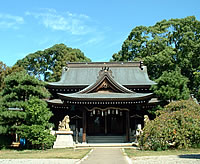
[ Large
view ]
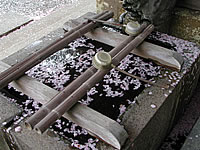
[ Large view ]
|
After the Meiji Restoration, the last lord of Himeji Castle, Tadakuni Sakai, was ordered to move to Tokyo in 1871. But the citizens of Himeji who missed the reign of the Sakai family started worshiping Masachika Sakai, the founder of Sakai family, with the permission from the Meiji National government in 1879. That was the beginning of this shrine. In 1925 the shrine was moved to the present location. Since 1961 successive lords of Himeji Castle from the Sakai family have been worshiped here to protect the castle.
More photos: [ 1 ] [ 2 ] [ 3 ]
[ Large view ] 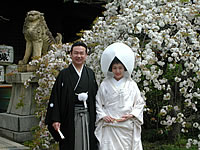 |
| |
|
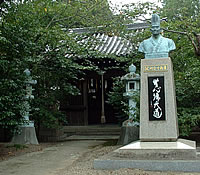
[ Large
view ] |
Sunno Shrine
This shrine is dedicated to Sunno Kawai who was a vice lord of Himeji Regional government and saved the government from financial difficulties. Sunno Kawai (1767~1841) developed local business throughout the Harima region, and he succeeded in paying back the deficit of 730,000 ryo (15 billion yen in the value of current money) in about 7 years. He also established a private school called Jinjuzan-ko and contributed to education by inviting famous scholars such as Sanyo Rai. The present shrine was built in 1957. |
| |
|
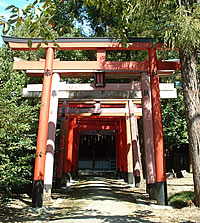
[ Large
view ] |
Iwakura Inari Shrine
Uganomitama-no-kami is worshiped at this shrine as the god of agriculture and manufacturing. It was originally located at Bohzu-machi, but moved to the present place in 1925. |
| [ Top ] |
| Himeji City Art Museum |
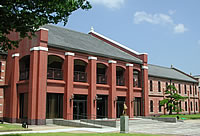
[ Large
view ] |
Himeji City Art Museum, located
to the east of the castle, exhibits many Belgium and French
works of modern art, and works by local artists. The museum
was originally built as a storage place for the army in the
Meiji period. The view of the white castle over the redbrick
museum is chosen as one of the 10 best places to see the castle.
More photos: [ 1 ] [ 2 ] |
| [ Top ] |
| Hyogo
Prefectural History Museum |
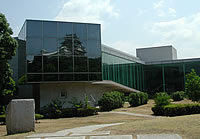 |
Hyogo Prefectural History Museum,
north of the Art Museum, exhibits the history of Hyogo Prefecture
and explains the castle and the city developed around the castle.
It shows how Himeji Castle, a grand example of wooden structure,
was built and functioned as a fortress. You can also try on
armor and “Juni-hitoe” (many-layered kimono) in
the museum. |
| [ Top ] |
| Himeji
Bungakukan (Literature Museum) |
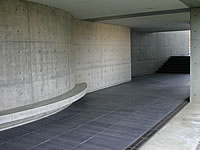 |
Tadao Ando, a world famous architect,
designed this “Himeji Bungakukan” (literature museum).
It exhibits many works, original writings and belongings of
writers related to the local Banshu area, such as Ryotaro Shiba,
Tetsuro Watsuji and Hosui Arimoto. The view from the museum’s
north building is magnificent. |
| [ Top ] |
| Kokoen
(Japanese Garden) |
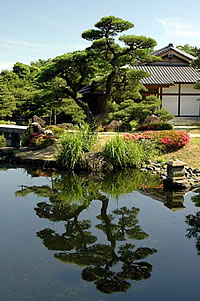 |
The 10,000-squre meter Japanese
Garden, “Kokoen”, west of Himeji Castle, is located where
the Lord’s “Western House” and samurai houses once stood.
By utilizing housing remains and pathways found during excavation,
9 gardens, including the Lord’s western house, Nagaya-mon
gate and Tsukiji-bei walls were replicated. You can enjoy
a meal or tea ceremony there while viewing the gardens filled
with seasonal flowers. [ Large
view ]
[ Large
view ] 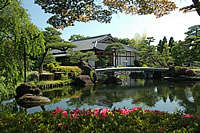 |
| [ Top ] |
| Harimanokuni-Sosha
Shrine |
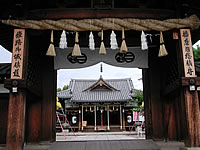 |
“Harimanokuni-Sosha”, officially
called the Itate-Hyozu Shrine, is dedicated to all gods and
deities worshiped in the local Harima area. The “Mitsuyama-matsuri” (Three
Mountain Festival) held every 20 years and the “Hitotsuyama-matsuri” (One
Mountain Festival) held every 60 years are unique. -  |
| [ Top ] |
| Keiunji
Temple |
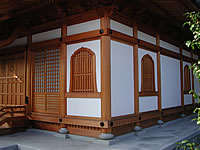
[ Large view ] -  |
In the “Keiunji Temple”,
there are memorials to two lovers, “Hiyokuzuka”,
honoring Onatsu and Seijuro who are heroine and hero in the
tragedy written by Saikaku Ihara and Monzaemon Chikamatsu.
After a forbidden love affair and running away, Seijuro was
executed, and Onatsu became insane. Now their memorials sit next
to each other, and people wish them togetherness in the
afterlife. |
| [ Top ] |
| Junisho
Shrine |
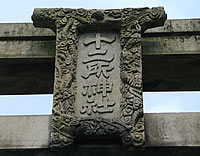 |
The “Junisho Shrine”,
located in the unlucky direction from Himeji Castle, has on
its sacred grounds a shrine worshiping Okiku, heroine of the
ghost story “Banshu-Sarayashiki”. Okiku was falsely
charged, killed and thrown into a well, which you can see at
Himeji Castle.
 |
| [ Top ] |

